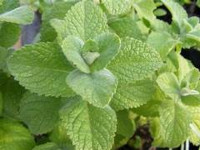Inhibitory Effect of Essential Oil from Rond Left Mint (Mentha Rotundifolia) on the Corrosion of C35 Mild Steel in an Acidic Environment http://www.doi.org/10.26538/tjnpr/v7i12.38
Main Article Content
Abstract
Metals such as iron are a target of different oxidative agents in acidic environments inducing significant economic losses. Ecological inhibitors of corrosion constitute an excellent alternative to chemical agents. Therefore, the scientific community proceeded to the use of plant extracts, including essential oils as inhibitors, presenting a cost-effective way to reduce steel losses. The present study was conducted to investigate the anticorrosive effect of Mentha rotundifolia essential oil in an acidic environment. Mentha rotundifolia essential oil was recovered using Clevenger apparatus. Different concentrations of essential oil were prepared (0.5, 1, 1.5, and 2g/L) to examine their anticorrosive impact on C35 steel in an acidic environment using 1M HCl by calculating electrochemical impedance, spectroscopic polarization curves, and weight loss measurement.
The results revealed that the essential oil yield was 1.58%. The EO showed an interesting anticorrosive effect at a concentration of 1g/L. Furthermore, the application of the EO at a concentration of 0.5g/L exhibited a higher anticorrosive effect by increasing double-layer capacitance to Cdl (77.41 µE/cm2). The findings of the study revealed that Mentha rotundifolia essential oil, at varying concentrations, effectively inhibited steel corrosion in an acidic environment.
Downloads
Article Details

This work is licensed under a Creative Commons Attribution-NonCommercial-NoDerivatives 4.0 International License.
References
Koch G. Cost of corrosion. Trends in oil and gas corrosion research and technologies. Trends Oil G Corr Res Tech. 2017;3–30.
Zhang Q, Zhang R, Wu R, Luo Y, Guo L, He Z. Green and high-efficiency corrosion inhibitors for metals: a review. Journal of Adhesion Science and Technology. 2023;37(9):1501–24.
Anejjar A, Salghi R, Jodeh S, Al-Deyab SS, Hammouti B, Elhassan AM. Inhibitive Action of Hydroxylammonium Sulfate on the Corrosion of Carbon Steel in Hydrochloric Acid Medieum and their Adsorption Characteristics. Moroccan J Chem. 2014;2(3):236–51.
Oguzie EE. Evaluation of the inhibitive effect of some plant extracts on the acid corrosion of mild steel. Nace Corrosion. Nace. 2010; p NACE-10149.
Bentrah H, Rahali Y, Chala A. Gum Arabic as an eco-friendly inhibitor for API 5L X42 pipeline steel in HCl medium. Corrosion Sci. 2014;82:426–31.
Ostovari A, Hoseinieh SM, Peikari M, Shadizadeh SR, Hashemi SJ. Corrosion inhibition of mild steel in 1 M HCl solution by henna extract: A comparative study of the inhibition by henna and its constituents (Lawsone, Gallic acid, α-d-Glucose and Tannic acid). Corrosion Sci. 2009;51(9):1935–49.
Left DB, Zertoubi M, Irhzo A, Azzi M. Review: oils and extracts plants as corrosion inhibitors for different metals and alloys in hydrochloric acid medium. J Mater Environ Sci. 2013;4(6):855–66.
Chetouani A, Hammouti B, Benkaddour M. Corrosion inhibition of iron in hydrochloric acid solution by jojoba oil. Pigment Resin Technol. 2004;33(1):26–31.
El Aoufir Y, Lgaz H, Bourazmi H, Kerroum Y, Ramli Y, Guenbour A, et al. Quinoxaline derivatives as corrosion inhibitors of carbon steel in hydrochloridric acid media: electrochemical, DFT and Monte Carlo simulations studies. J Mater Environ Sci. 2016;7(12):4330–47.
El-Shamy AM, Mouneir SM. Medicinal Materials as Eco-friendly Corrosion Inhibitors for Industrial Applications: A Review. J Bio Tribo Corros. 2023 Mar;9(1):3.
Zaferani SH, Sharifi M, Zaarei D, Shishesaz MR. Application of eco-friendly products as corrosion inhibitors for metals in acid pickling processes–A review. J Environ Chem Eng. 201;1(4):652–7.
Bentiss F, Traisnel M, Lagrenee M. Influence of 2, 5-bis (4-dimethylaminophenyl)-1, 3, 4-thiadiazole on corrosion inhibition of mild steel in acidic media. J App Electrochem. 2001;31(1):41–8.
Valle-Quitana JC, Dominguez-Patiño GF, Gonzalez-Rodriguez JG. Corrosion inhibition of carbon steel in 0.5 M H2SO4 by phtalocyanine blue. Inter Scholar Res Not. 2014;2014:1-8.
Khoshkhou Z, Torkghashghaei M, Baboukani AR. Corrosion inhibition of henna extract on carbon steel with hybrid coating TMSM-PMMA in HCL solution. Open Journal of Synthesis Theory Appl. 2018;7(1):1–16.
El-Etre AY. Inhibition of acid corrosion of carbon steel using aqueous extract of olive leaves. J Colloid Inter Sci. 2007;314(2):578–83.
Khadraoui A, Khelifa A, Hamitouche H, Mehdaoui R. Inhibitive effect by extract of Mentha rotundifolia leaves on the corrosion of steel in 1 M HCl solution. Res Chem Intermed. 2014 Mar;40(3):961–72.
Khadraoui A, Khelifa A, Boutoumi H, Hamitouche H, Mehdaoui R, Hammouti B. Adsorption and inhibitive properties of Ruta chalepensis L. oil as a green inhibitor of steel in 1 M hydrochloric acid medium. Inter J Electrochem Sci. 2014;9(6):3334–48.
Abiola OK, James AO. The effects of Aloe vera extract on corrosion and kinetics of corrosion process of zinc in HCl solution. Corrosion Sci. 2010;52(2):661–4.
Halambek J, Berković K, Vorkapić-Furač J. The influence of Lavandula angustifolia L. oil on corrosion of Al-3Mg alloy. Corrosion Sci. 2010;52(12):3978–83.
Abiola OK, Otaigbe JOE. The effects of Phyllanthus amarus extract on corrosion and kinetics of corrosion process of aluminum in alkaline solution. Corrosion Sci. 2009;51(11):2790–3.
Abdel-Gaber AM, Abd-El-Nabey BA, Saadawy M. The role of acid anion on the inhibition of the acidic corrosion of steel by lupine extract. Corrosion sci. 2009;51(5):1038–42.
Bustos E, Godínez LA. Modified surfaces with nano-structured composites of Prussian blue and dendrimers. New materials for advanced electrochemical applications. Inter J Electrochem Sci. 2011;6(1):1–36.
Vinutha MR, Venkatesha TV. Review on mechanistic action of inhibitors on steel corrosion in acidic media. Portugaliae Electrochim Acta. 2016;34(3):157–84.
Udhayakala P. Quantum chemical studies on the inhibition potentials of thiophene derivatives for the corrosion inhibitors of carbon steel. J Chem Pharm Res. 2015;7(1):803–10.
El Ouasif L, Merimi I, Zarrok H, Elghoul M, Achour R, Guenbour M, et al. Synthesis and inhibition study of carbon steel corrosion in hydrochloric acid of a new surfactant derived from 2-mercaptobenzimidazole. J Mater Environ Sci. 2016;7(8):2718–30.


